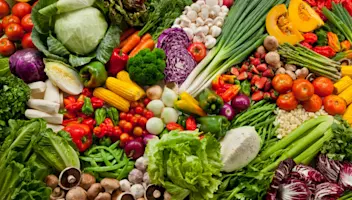Featured in this post
How a Food Production ERP Facilitates the 6 Key Steps in Product Manufacturing
How a Food Production ERP Facilitates the 6 Key Steps in Product Manufacturing
22 Sep 2022
Jack Payne
The process of digital transformation is best framed as a journey, as there are several steps to accomplish along the way before an organization can say that they’ve truly modernized for today’s business landscape. Fittingly, food and beverage companies—for which digital transformation is an urgent imperative—also face a journey of sorts in the course of daily operations as they follow the path of production from “farm to fork.”
Your business is highly incentivized to execute optimally at each stage in the supply chain in order to ensure that your finished goods meet the ever-increasing demands of consumers and government regulatory agencies. Of course, that’s easier said than done, as food and beverage production processes are highly specialized and nuanced, requiring the right balance of priorities to meet your quality, efficiency and profitability goals.
That’s why it’s a smart move to look into how purpose-built, industry-specific technology can support your efforts. The software solutions built with food and beverage companies in mind have come a long way in recent years, with enterprise resource planning (ERP) systems at the forefront of this development thanks to the fact that the best among them offer dedicated features for each phase of manufacturing.
But what exactly are these features, and how do they benefit your business and drive better outcomes? Let’s take a closer look at the details with this walk through of the steps of food and beverage production. In particular, we’ll emphasize how a food production ERP can boost results and help ensure that you meet—and hopefully exceed—both your internal targets as well as the expectations of critical clients, discerning shoppers and strict enforcement agencies.
Step 1: Managing Suppliers and Inbound Raw Materials
In this first step of the operational journey, you must effectively and affordably secure the ingredients that you need to manufacture your products. That means researching your options and settling on a reasonable price, streamlining your ordering process and keeping tabs on supplier performance by confirming that what they deliver adheres to the specifications you’ve agreed upon; affirming sustainable and responsible sourcing.
An advanced food production ERP solution like Aptean Food & Beverage ERP helps you create orders quickly using a vendor item catalogue, facilitating an easier process that’s less prone to error. Such systems also allow you to establish inspection statuses that hold incoming lots until necessary quality checks can be performed so that you know what you’ve received is up to snuff.
What’s more, the right food ERP platform can also let you track over- and under-delivery of inbound materials, set deviation tolerances and alert your employees when a particular shipment falls outside the acceptable range. Combined, these features serve to improve your procurement processes so that you can know that you’ll always have what you need to manufacture your finished products.
Step 2: Inventory and Warehouse Management
Once materials have been received, it’s critical that you store them properly and in an organized fashion so that you know what you have and your workers can efficiently and accurately pick what’s needed for the day’s production schedule. A food and beverage warehouse can become a crowded and chaotic place, but industry-specific ERP software can help you closely monitor your stock and track its movement throughout the warehouse and beyond.
That starts with robust lot and sublot management systems, which give you end-to-end traceability down to the individual item level from receipt through distribution to clients. Aptean Food & Beverage ERP also offers strong tools for shop floor logistics so that you can dig into the details of your bin and lot contents and zoom in for granular accuracy.
Our solution also allows you to use license plating and/or serial shipping container codes (SSCCs) to track lots no matter where they are in the supply chain. With our system, your employees can also be empowered by the mobile warehouse module, which lets them leverage handheld barcode scanners to expedite the identification, picking and movement of inventory in a fully digital and more precise fashion.
Lastly, the right food production ERP will also let you establish tolerance ranges for your workers’ picking procedures. With notifications automatically triggered for instances of over- and/or under-picking of materials that violate your predetermined thresholds, managers can stay informed and help correct issues before they result in larger problems down the road.
Step 3: Demand and Production Planning
This somewhat tricky stage in the production process involves looking forward in time and aligning all aspects of your operations with the expected demand for your items. That includes setting the production schedules you’ll need to execute on in order to satisfy clients’ appetites for your food and beverage offerings.
A sound food manufacturing ERP will provide a production scheduling setup that facilitates the optimization of your resources and minimizes slack times and periods of lost productivity. Aptean Food & Beverage ERP also has the production planning features that you need to keep your teams up to speed on what is necessary in terms of raw materials so that your supply can be finely tuned according to expected demand.
Step 4: Production
Now it’s time to actually manufacture your food and beverage products, which is likely the most critical and complex of these steps and requires attention to a variety of considerations. It would be quite challenging to juggle all of the important matters involved, so this is where you really need purpose-built technology like a food production ERP to assist in managing them all.
For the crucial concern of quality control, advanced systems like Aptean’s food ERP have features dedicated to the purpose that set in motion periodic inventory inspections, auto-creation of quality checklists and even the capability to attach photos or documents to record issues. Our software also lets you store all of your compliance documents in a single digital repository for easy reference.
Furthermore, the ability to define different production scenarios unlocks flexibility by allowing you to assign primary and backup plans based on the product line in question so that you can overcome shortages and surpluses of raw goods. Aptean Food & Beverage ERP also facilitates expiration tracking and deploys proactive warnings when stock is approaching the end of its window of viability.
Because you’ve likely got multiple product lines, you’ll want to take advantage of an ERP’s integrated product specification database so that you can link raw materials to your various recipes and automatically generate bills of materials (BOMs) and final lists of ingredients, allergens and nutritional info. And beyond that, status flows can be employed to queue up mandatory actions based on certain criteria associated with individual items, specific purchase or sales orders and even client specifications.
Step 5: Sales and Customer Relationship Management (CRM)
As important as the prior steps are, your work in progressing through each could all be for naught if your teams can’t sell products and satisfy customers through reliable service and finished goods. Leading food production ERPs like Aptean‘s shine with their versatility, providing the features you need for this critical matter alongside more manufacturing-oriented tools.
For starters, these food systems with CRM can handle advanced pricing structures, including hierarchical pricing; discounting in percentage or dollar amounts; different discounts for sell-to customers and ship-to addresses; and pricing based on shipment, requested delivery or promised delivery date. You can also track non-conformances that customers report with the ability to quickly intervene and make things right.
Meanwhile, your clients can access a customer order catalogue for a self-serve experience that’s faster, more convenient and less likely to result in mistakes when compared to traditional methods. Aptean Food & Beverage ERP also allows for the creation of a comprehensive trade management system that lets your employees create multi-level trade agreements with customers that include variable prices, discounts, promotions, rebates, broker commissions, payables, royalties and billbacks.
Step 6: Outbound Logistics
You’re at the final stage of the food and beverage production journey, but the work isn’t done quite yet. You’ve still got to get your clients their orders and manage the matter of distribution efficiently to ensure that deliveries are made on time and in full, and you’re much more likely to succeed in that endeavor with the help of the features that a food production ERP provides.
These include tools to create identification labels for your goods and lots, customizable in what data is included—from customer name and shipping address to item and/or lot numbers, nutritional values and ingredient details. Functionality that helps you make sure you’ve got the necessary crates, pallets and other packaging materials is also built into optimized food ERP solutions, and the best among them also facilitate auto-ordering replenishments when supplies run low.
Also consider that Aptean Food & Beverage ERP can create visualizations of your transportation needs as orders come in so that you can effectively combine orders on a single truck or transport order to save on costs. That can be a game-changer in an era of elevated gas prices and rising operating costs, making a real difference for your bottom line.
Get the Edge on the Competition with Aptean Food & Beverage ERP
We’ve reached the end of our walkthrough, taking the time to highlight the strengths of food production ERP systems and our own solution in particular each step of the way. While there are plenty of options on the market if you’re looking to make the wise choice of implementing an ERP, but there are a few more advantages of Aptean Food & Beverage ERP that you should know about before you shop around.
To begin with, there’s our teams’ deep expertise in the food and beverage marketplace—we know the challenges you face, the best practices to employ and how highly complex and specialized processes require purpose-built tools for their optimal execution. Our long track record of serving food and beverage businesses is demonstrated by the number of clients we’ve helped to get on track with their digital transformations.
Our software was also recently recognized with Frost and Sullivan’s prestigious 2022 Product Leadership Award in North American ERP Software for the Food and Beverage Industry, which demonstrates not only its superior quality but also our mission to get our clients Ready for What’s Next, Now®. We offer flexible cloud deployments based on a software as a service (SaaS) model to maximize agility, reliability and mobile accessibility.
Finally, there’s the fact that we built our industry-specific technology on the Microsoft Dynamics 365 Business Central platform, which means Aptean Food & Beverage ERP has a familiar, user-friendly interface that’s intuitive for your employees to use in their day-to-day responsibilities. When you add it all together, we’re confident you’ll realize our solution should be at the top of your list.
Ready to learn more about Aptean Food & Beverage ERP and how it can help you effectively manage the food production process? Contact us today, or request a personalized demo to see the software in action for yourself.
Related Content


Aptean Food & Beverage ERP Customer Success Stories
These 10 clients from across various food and beverage sectors achieved more with our solution.






